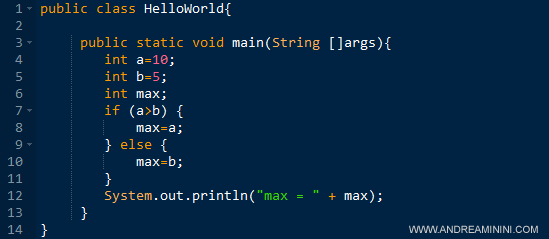

- #If else statements in freemat how to#
- #If else statements in freemat install#
- #If else statements in freemat software#
- #If else statements in freemat code#
- #If else statements in freemat license#
#If else statements in freemat how to#
This is convenient in that you do not worry about how to peform operations on different data types. There are no separate types for integers or booleans, rather they are double precision numbers that are treated in a special way. We will look at some examples of how to do this in the coming labs.Įverything also is done using double precision floating point numbers in MATLAB. This is important to know when you read data from a file into MATLAB, because numbers will be read into consecutive locations in memory from the file. However, there are two different ways we could store the 4 matrix entries in memory: we can either store the first row, then the second row, or we can store the first column, then the second column. if a matrix A contains 3 elements, then A(1) is the first element and A(3) is the last element), and does so using a convention known as “column major order.” This refers to how the data is arranged in the computer’s memory: if we want to create a 2x2 matrix, MATLAB sets aside enough memory to store 4 floating point numbers.

MATLAB stores matrices using the 1-indexing convention (i.e. Even if you just want to consider a single floating point number in MATLAB, it is treated as a 1x1 matrix. This is very convenient for doing numerical analysis of data, because as we have seen with Python, we very often need to represent arrays of data in scientific settings. The main philosophy in MATLAB is that everything is a matrix (specifically, a matrix of floating point numbers with double precision).
#If else statements in freemat code#
If you decide to use something other than version of MATLAB in the Mac Lab, all I ask is that you be sure that MATLAB in the Lab can run all of your code, as I like to run your code myself – if I have to substantially tweak your code to get it to work, I will take points off. You are also free to use one of the open source alternatives, as long as you use one that has the same syntax as MATLAB. The computers have been updated to the most recent release, though most of what we cover should work on other versions of MATLAB. In this course, we will be doing our lab exercises in the Mac Lab using MATLAB.
#If else statements in freemat software#
You will no doubt encounter software for geophysical research that has been written in MATLAB. Regardless of all that, MATLAB is a fixture in science and engineering, and you will need to be familiar with it in any career path you choose. I use Python along with a number of additional packages in my research in place of MATLAB, though that has been born out of the fact that I simply like programming in Python better (rather than the fact that MATLAB is commercial). I have found it mostly compatible with existing MATLAB code, though I often have to make a few modifications and sometimes must replace functions that do not exist in Octave (and some Octave code is not compatible with MATLAB).
#If else statements in freemat install#
I have used GNU Octave extensively in my research in addition to MATLAB, as it is fairly easy to install under various Linux distributions. Some of these are meant to be MATLAB clones – GNU Octave and FreeMat are supposed to run MATLAB code with the same syntax, while the others have a distinct syntax. For those that have strong feelings about proprietary software, there are a number of free open source alternatives: GNU Octave, FreeMat, SciLab, R, a combination of Python packages, etc.
#If else statements in freemat license#
MATLAB is commercial software (we have a license for it on all of the computers in the Mac Lab). MATLAB currently uses a proprietary version of the LAPACK linear algebra routines. It is commonly used in academic, research, and industrial settings (which is why geophysicsts should know how to use it).

MATLAB was originally a package for matrix math, designed to provide an interface to linear algebra libraries written in Fortran, but has grown over the years into a software package useful for a range of scientific applications. Additional toolboxes add further capabilities for extending MATLAB beyond its basic functionality.Built in 2D and 3D graphics capabilities.Many, many built-in functions (we will only scratch the surface in this class).Interactive and “interpreted” (there is a “compiler” that makes code run faster), runs.Fundamental data type is matrix (double precision floating point numbers).MATLAB is short for MATrix LABoratory, and is a common high-level tool for numerical analysis in science and engineering.


 0 kommentar(er)
0 kommentar(er)
